Undergraduate Statistics Degrees Up 474% Since 2010
Steve Pierson, ASA Director of Science Policy
The number of statistics and biostatistics bachelor’s degrees awarded in 2020 increased 474 percent since 2010, capping what can justifiably be termed the decade of statistics.
Master’s degrees had a 136 percent increase for the same period and doctoral degrees had a 64 percent increase, based on the latest preliminary data release for 2020 degree completions from the National Center for Education Statistics (NCES).
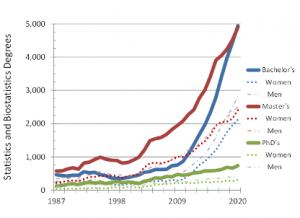
Figure 1. Statistics and biostatistics degrees at the bachelor’s, master’s, and doctoral levels in the United States for 1987–2020. The dotted lines of matching colors are the number of degrees for that degree level earned by women; the dash-dotted is for men. Data source: NCES IPEDS.
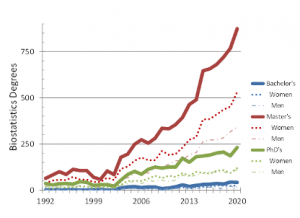
Figure 2. Biostatistics degrees by degree level awarded in the United States. The dotted lines on matching colors are the number of degrees for that degree level earned by women; the dash-dotted is for men.
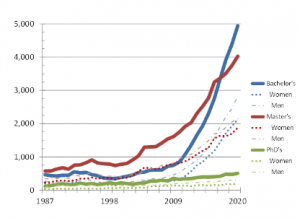
Figure 3. Statistics degrees by degree level awarded in the United States. The dotted lines on matching colors are the number of degrees for that degree level earned by women; the dash-dotted is for men.
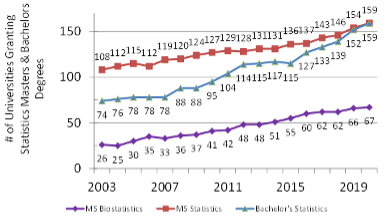
Figure 4. The number of universities granting statistics and biostatistics master’s and bachelor’s degrees. Compiled from NCES IPEDS data.
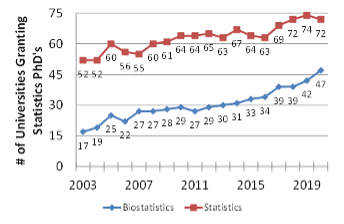
Figure 5. The number of universities granting statistics and biostatistics PhDs. Compiled from NCES IPEDS data.
For 2019 to 2020, bachelor’s degrees grew 12 percent to 4,942 (42 of which are for biostatistics), master’s degrees grew nine percent to 4,900 (874 for biostatistics), and doctoral degrees grew 12 percent to 736 (231 for biostatistics), as seen in Figure 1.
The 2020 degree completion release also marked the decadal updating of the NCES system for categorizing degrees, adding a Classification of Instructional Programs (CIP) code for data science in the general CIP category of multidisciplinary studies. A CIP code for applied statistics was also added in the general CIP category of mathematics and statistics, the same one in which the CIP code for statistics is placed.
The applied statistics degrees granted in 2020 are included below with statistics and number 36, 130, and eight for bachelor’s, master’s, and doctorates, respectively.
While the growth of bachelor’s degrees is dominated by statistics—and the overall number of master’s and doctoral degrees being two to four times greater for statistics than biostatistics—the percentage growth in graduate degrees for both fields has been roughly similar since 2010, as seen in Figures 2 and 3.
The increase in the number of universities granting statistics and biostatistics degrees also continues steadily. From 2019 to 2020, those granting bachelor’s degrees in statistics increased from 152 to 159, master’s degrees in statistics increased from 154 to 159, and doctoral degrees in biostatistics increased from 42 to 47, as seen in Figures 4 and 5. The corresponding number for doctoral degrees in statistics dropped from 74 to 72. Seven and 67 universities granted biostatistics degrees at the bachelor’s and master’s levels in 2020, respectively.
The following 28 universities granted statistics and biostatistics degrees for the first time (at least since 2003) in 2020:
- Bachelor’s degrees in statistics (14): Arizona State University Campus Immersion, California State University-Monterey Bay, Dordt University, Lindenwood University, Metropolitan State University of Denver, Purdue University Fort Wayne, Saint Michael’s College, SUNY at Albany, The University of Texas at Dallas, The University of Texas Rio Grande Valley, University of Arizona, University of Colorado Boulder, University of Southern Indiana, University of the Incarnate Word
- Master’s degrees in statistics (7): Azusa Pacific University, CUNY Graduate School and University Center, University of Alaska Fairbanks, Tufts University, University of Nevada-Reno, University of New Hampshire-Main Campus, University of Wisconsin-La Crosse
- Master’s degrees in biostatistics (3): New York University, SUNY at Albany, West Virginia University
- PhD in statistics (1): University of California-Santa Cruz
- PhD in biostatistics (3): Medical University of South Carolina, SUNY at Albany, University of Nebraska Medical Center
The top degree-granting institutions over the last five years are in the following tables for all categories except biostatistics bachelor’s degrees.
Table 1–Top Five Universities Granting Statistics PhDs for 2016–2020
Table 2–Top Five Universities Granting Biostatistics PhDs for 2016–2020
Table 3–Top Five Universities Granting Statistics Master’s Degrees for 2016–2020
Table 4–Top Five Universities Granting Biostatistics Master’s Degrees for 2016–2020
Table 5–Top Five Universities Granting Statistics Bachelors Degrees for 2016–2020
*The North Carolina State and Iowa State University PhD numbers include one and four applied statistics degrees, respectively, in 2020.
Demographics
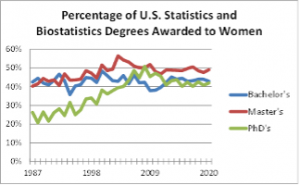
Figure 6: Percentage of statistics and biostatistics degrees awarded to women by degree level for 1987–2020. Data Source: NCES IPED
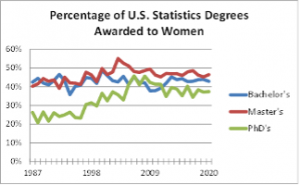
Figure 7: Percentage of statistics degrees awarded to women by degree level for 1987–2020. Data Source: NCES IPED.
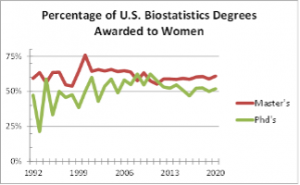
Figure 8. Percentage of master’s and PhD biostatistics degrees awarded to women for 1992–2020. Data Source: NCES IPED.

Figure 9. The percent of statistics and biostatistics degrees earned by women compared with five other, much larger fields. “(Bio)Statistics” is both statistics and biostatistics. The data source is NCES IPEDS using CIP code 11.07 for computer science; 14.10 for electrical engineering; 26.01 for biology; 27.01 for mathematics; and 40.08 for physics.
Following our practice of alternating demographics updates, we look at the breakdown of degrees earned by men and women this year. Last year’s update, which was based on 2019 degree data, had figures for the percentage of statistics and biostatistics degrees earned by nonresident aliens and race and ethnicity data for the degrees granted to US citizens or residents.
Figures 6–8 show the percentage of degrees earned by women over time by degree level for combined statistics and biostatistics, statistics only, and biostatistics only. The percentage of women earning biostatistics degrees is higher than that of men for all degree levels. For statistics, the percentage of men earning degrees is higher at all levels. The percentage of PhDs earned by women has declined modestly since 2008, while the same percentage for bachelor’s degrees has increased modestly since the late 2000s. The percentage of women earning statistics and biostatistics degrees is generally better than other quantitative STEM fields, especially at the graduate degree levels and for those in the physical, mathematical, and computer sciences, as illustrated in Figure 9.
2020 Marks Introduction of New Data Science Category
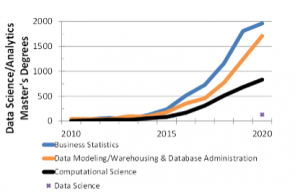
Figure 10. Master’s degrees awarded from 2010–2020 for three CIP categories commonly used by new data science/analytics programs. The graph also shows the number of master’s degrees awarded in 2020 using the new CIP code for “data science.”
Accounting for the emergence of data science as a new degree over the past decade, NCES introduced a Classification of Instructional Programs (CIP) code for data science in their decadal CIP update. Placed in the general CIP category of multidisciplinary studies, the new category showed 84 and 160 for bachelor’s and master’s degrees, respectively. Thirteen universities awarded such degrees for each level.
Prior to the introduction of the new CIP code, the ASA canvassed departments for how they were categorizing to NCES their master’s degrees in data science, data analytics, or related field. We identified three main categories, as shown in the figure and table. The largest, by both number of master’s degrees granted annually and number of universities granting them, is business statistics, in the general CIP category of Business, Management, Marketing, and Related Support Services. Data Modeling/Warehousing & Database Administration, in the general CIP category of Computer and Information Sciences and Support Services, has also been widely used. Another category commonly used is Computational Science, in the same general CIP category as “Data Science.”
It’s not clear that the new “data science” CIP code substantially impacted for 2020 master’s degree reporting the use of the three categories discussed here. One possible mitigating factor is that the Department of Homeland Security does not yet include “data science” CIP code in its STEM Designated Degree Program List, which is used by DHS to determine eligibility for the 24-month STEM optional practical training (OPT) extension. The omission affects international students seeking to study in a data science program through STEM OPT.























